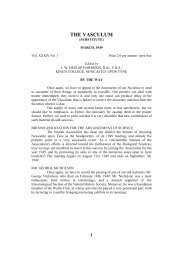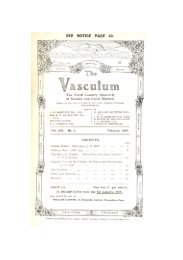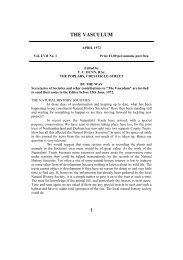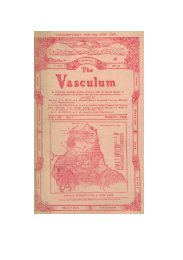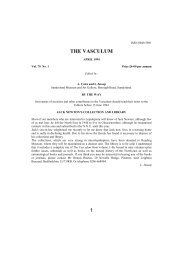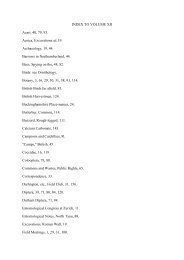1938 - The Vasculum
1938 - The Vasculum
1938 - The Vasculum
You also want an ePaper? Increase the reach of your titles
YUMPU automatically turns print PDFs into web optimized ePapers that Google loves.
23<br />
On one of the Whittle Dene Reservoirs, run off for twelve<br />
months, we took Zonitoides nitidus. This snail has only been taken in V.C.<br />
67 by Alder in Heaton Dene and H. Watson (1890) near Corbridge. <strong>The</strong>re is<br />
one record in 1912 by A. M. Oliver for V.C. 68, at Spindleston. Helix<br />
nemoraiis and H. hortensis swarmed on the banks of one of the reservoirs in<br />
close conjunction, which is very unusual. As an aside: recently the absence<br />
of many Helices on the coast line of the two counties was partly accounted<br />
for by a native who said that he and others were accustomed to cook and eat<br />
these snails. <strong>The</strong> fact has been strenuously denied, but this confirms the<br />
statement previously made.<br />
Certain incidental observations should be noted. In the Farding<br />
Lake, Whitburn, the bodies of Limnaea peregra were very yellow of an<br />
unusually deep colour, similar to the colour of the Anodontacygncaea taken<br />
in the magnesian limestone area ponds at East Boldon, probably due to the<br />
presence of the limestone. <strong>The</strong> re-crudescence of <strong>The</strong>ba cantiana in<br />
Northumberland noted last year has been further and strikingly exemplified.<br />
<strong>The</strong> presence of' albinism in slugs, especially in the millstone grit area, has<br />
been very marked. A rare form of Arion subfuscus was found in Benridge<br />
Bog. Arion ater albida and alba-lateralis have been fairly frequent,<br />
especially in the west, and at CatcIeugh there was quite a brood of the<br />
albida. Albinism is said by some authorities to be a feature of chalky<br />
districts; others say it is due to dwelling in shady forests, others that it<br />
occurs where the species has reached its horizontal and vertical limit. <strong>The</strong><br />
matter needs further investigation and is a good subject for research.<br />
Hydrobia jenkinsi also is spreading steadily in Northumberland. <strong>The</strong> new<br />
areas are at R. Pont, Berwick Hill, Whittle Dene Reservoir, West<br />
Cramlington and New York near Whitley Bay. In Durham it swarms. This<br />
species simply crowds out other species by its swarming. A very remarkable<br />
Limncea peregra ovata was found in the old Marden Lake at Cullercoats,<br />
heavily impregnated with magnesian lime-stone. <strong>The</strong> shells were large,<br />
solid, highly polished, very rounded, and had the consistency and almost the<br />
shape of the marine Natica catena-doubtless another effect of the<br />
magnesian limestone.



